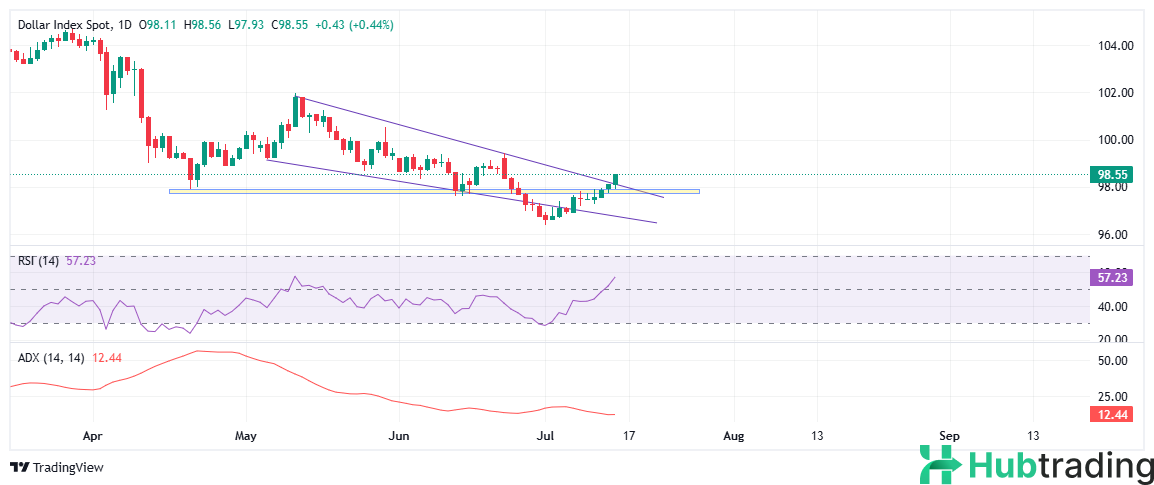-
The US Dollar strengthens following the June CPI report, with the DXY climbing above the key 98.00 mark.
-
Market sentiment remains wary due to ongoing tariff threats from President Donald Trump.
-
Headline CPI increased by 0.3% month-over-month in June, pushing the annual rate to 2.7%, in line with expectations.
The US Dollar (USD) advanced notably on Tuesday after the release of the June Consumer Price Index (CPI) report. Although the overall gains were modest, the Greenback found support as the data showed headline inflation met expectations, while core inflation came in slightly below forecasts. This combination reinforced expectations that, despite ongoing price pressures, the Federal Reserve (Fed) may maintain a cautious stance on rate cuts, keeping the door closed for immediate policy easing.
The US Dollar Index (DXY) jumped to a three-week high, breaking through key resistance levels to trade near 98.50 during the US session. The clean break above the 98.00 psychological level and wedge resistance signaled renewed bullish momentum, buoyed by diminishing expectations of near-term Fed rate cuts. However, overall market sentiment remained risk-averse, as continued tariff threats from President Donald Trump weighed on investor confidence.
The June CPI report showed a notable rise in price pressures. Headline inflation increased by 0.3% month-over-month — the largest gain in five months — lifting the annual rate to 2.7% from 2.4% in May. Both figures were in line with market forecasts. In contrast, Core CPI, which strips out volatile food and energy prices, rose just 0.2% MoM versus the expected 0.3%, though the year-over-year rate edged up to 2.9% from 2.8%, reflecting persistent underlying inflation.
The data pointed to solid price gains in energy, transportation, and sectors affected by tariffs, suggesting that trade-related inflation is beginning to impact consumers more directly.
Fed Chair Jerome Powell has emphasized that uncertainty surrounding the economic impact of tariffs is a key reason for the central bank’s cautious approach. He noted that the Fed paused rate adjustments when the scale of the tariffs became clear and will continue to evaluate how deeply these measures influence inflation and growth before considering policy easing.
While some Fed officials believe the inflationary impact of tariffs may be transitory, others are concerned it could prove more persistent, making it more challenging for the Fed to justify rate cuts in the short term.
Market Movers: Trump Ramps Up Tariff Threats, Fed Criticism Intensifies
- Following the June CPI release, President Donald Trump reignited pressure on the Federal Reserve, demanding immediate interest rate cuts via a post on Truth Social: “Consumer Prices LOW. Bring down the Fed Rate, NOW!!!” Trump argued that lower rates could save the U.S. government over a trillion dollars annually in interest payments, amplifying the political spotlight on the Fed as inflation remains elevated and markets continue to price in only gradual easing.
- On the geopolitical front, Trump announced plans to impose “very severe tariffs” — potentially as high as 100% — on Russian exports unless a peace agreement with Ukraine is reached within 50 days. He further threatened “secondary tariffs” on countries continuing to trade with Russia, singling out major energy importers like China, India, and Turkey. These aggressive measures have deepened global market unease, raising concerns over renewed disruptions in energy and commodity supply chains.
- The benchmark U.S. 10-year Treasury yield held steady above 4.43% on Tuesday, hitting a one-month high. The sustained uptick reflects investor concerns that tariff-related inflation could linger, prompting the Fed to postpone any potential rate cuts until clearer disinflationary signals emerge.
- Meanwhile, the second-quarter U.S. earnings season kicks off this week, with financial giants JPMorgan, Citigroup, and Goldman Sachs set to report. Analysts anticipate modest year-over-year earnings growth of 5.8%, down sharply from the 10.2% projected in April. The downward revision highlights growing concerns over rising input costs and the chilling effects of trade tensions on corporate profitability.
- Adding to the Fed drama, Trump escalated his personal attacks on Chair Jerome Powell, calling him a “knucklehead” and accusing him of keeping rates too high. Trump argued that rates should already be closer to 1%, and accused Powell of harming the economy by refusing to act aggressively. In a further swipe, Trump’s administration is reportedly scrutinizing the Fed’s recent $2.5 billion headquarters renovation project, suggesting the expenditure was excessive and hinting that Powell could be removed “for cause.”
- While the Supreme Court has signaled that a president cannot fire a Fed Chair over policy disagreements, removal could be possible in cases of misconduct or mismanagement. National Economic Council Director Kevin Hassett confirmed that the White House is "looking into" this avenue. According to The Washington Post, Hassett is being considered as a potential replacement for Powell, a move that could stoke fears about the Fed's independence given Hassett’s alignment with Trump’s call for aggressive rate cuts.
Technical Analysis: DXY Breaks Out as Bullish Momentum Builds

The US Dollar Index (DXY) has confirmed a bullish breakout after consolidating within a falling wedge formation for several sessions. The index has steadily climbed over the past two weeks, underpinned by support from the 9-day moving average at 97.70. During the U.S. session, DXY surged above the key 98.00 resistance level and extended gains toward 98.55, signaling a potential continuation toward the 98.80–99.00 zone.
Momentum indicators are turning increasingly supportive of the move. The Relative Strength Index (RSI) has risen to 57.23, reflecting renewed buying interest. However, the Average Directional Index (ADX) remains subdued at 12.44, indicating that while the trend is gaining traction, it's still in its formative stages and lacks full confirmation.
Immediate support is now located at the 98.00 level — the former resistance turned support — with further downside protection at the 9-day EMA near 97.70. With the inflation data already priced in, market focus will shift to whether the DXY can sustain its breakout and attract follow-through buying in the sessions ahead.





